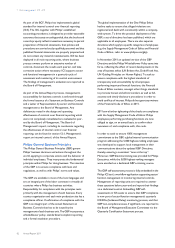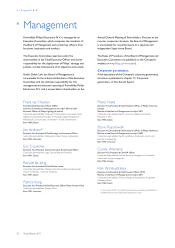Philips 2011 Annual Report Download - page 86
Download and view the complete annual report
Please find page 86 of the 2011 Philips annual report below. You can navigate through the pages in the report by either clicking on the pages listed below, or by using the keyword search tool below to find specific information within the annual report.7 Risk management 7.3 - 7.4
86 Annual Report 2011
Philips itself may have made. Additionally, Philips partners
or members of a joint venture or associated company may
not be able to meet their financial or other obligations,
which could expose Philips to additional financial or other
obligations, as well as adversely affect the value of its
investments in those entities or potentially subject Philips
to additional claims.
Philips’ inability to secure and retain intellectual property
rights for products, whilst maintaining overall
competitiveness, could have a material adverse effect on
its results.
Philips is dependent on its ability to obtain and retain
licenses and other intellectual property (IP) rights
covering its products and its design and manufacturing
processes. The IP portfolio is the result of an extensive
patenting process that could be influenced by a number
of factors, including innovation. The value of the IP
portfolio is dependent on the successful promotion and
market acceptance of standards developed or co-
developed by Philips. This is particularly applicable to
Consumer Lifestyle where third-party licenses are
important and a loss or impairment could adversely
impact Philips’ financial condition and operating results.
Philips’ ongoing investments to raise its brand preference
could have less impact than anticipated.
Philips has made large investments in the reshaping of the
Group into a more market-driven company focusing on
delivering advanced and easy-to-use products and easy
relationships with Philips for its customers. If Philips fails
to deliver on its brand promise, its growth opportunities
may be hampered, which could have a material adverse
effect on Philips’ revenue and income.
Philips’ overall performance in the coming years is
dependent on realizing its growth ambitions in growth
geographies.
Growth geographies are becoming increasingly important
in the global market. In addition, Asia is an important
production, sourcing and design center for Philips. Philips
faces strong competition to attract the best talent in tight
labor markets and intense competition from local
companies as well as other global players for market share
in growth geographies. Philips needs to maintain and grow
its position in growth geographies, invest in local talents,
understand developments in end-user preferences and
localize the portfolio in order to stay competitive. If
Philips fails to achieve this, its growth ambitions, financial
condition and operating results could be affected
materially.
7.4 Operational risks
Failure to achieve improvements in Philips’ solution and
product creation process and/or increased speed in
innovation-to-market could hamper Philips’ profitable
growth ambitions.
Further improvements in Philips’ solution and product
creation process, ensuring timely delivery of new
solutions and products at lower cost and upgrading of
customer service levels to create sustainable competitive
advantages, are important in realizing Philips’ profitable
growth ambitions. The emergence of new low-cost
competitors, particularly in Asia, further underlines the
importance of improvements in the product creation
process. The success of new solution and product
creation, however, depends on a number of factors,
including timely and successful completion of
development efforts, market acceptance, Philips’ ability to
manage the risks associated with new products and
production ramp-up issues, the availability of products in
the right quantities and at appropriate costs to meet
anticipated demand and the risk that new products and
services may have quality or other defects in the early
stages of introduction. Accordingly, Philips cannot
determine in advance the ultimate effect that new
solutions and product creations will have on its financial
condition and operating results. If Philips fails to accelerate
its innovation-to-market processes and fails to ensure that
end-user insights are fully captured and translated into
solution and product creations that improve product mix
and consequently contribution, it may face an erosion of
its market share and competitiveness, which could have a
material adverse affect on its financial condition and
operating results.
If Philips is unable to ensure effective supply chain
management, e.g. facing an interruption of its supply chain,
including the inability of third parties to deliver parts,
components and services on time, and if it is subject to
rising raw material prices, it may be unable to sustain its
competitiveness in its markets.
Philips is continuing the process of creating a leaner supply
base with fewer suppliers, while maintaining dual sourcing
strategies where possible. This strategy very much
requires close cooperation with suppliers to enhance,
amongst other things, time to market and quality. In
addition, Philips is continuing its initiatives to reduce
assets through outsourcing. These processes may result
in increased dependency. Although Philips works closely
with its suppliers to avoid supply-related problems, there
can be no assurance that it will not encounter supply
problems in the future or that it will be able to replace a
























